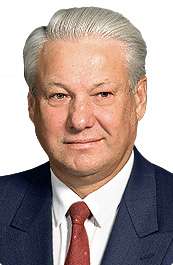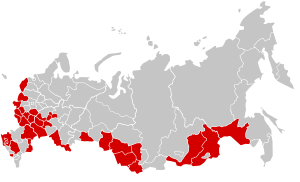Russian presidential election, 1996
| | ||||||||||||||||||||||||||||||
| ||||||||||||||||||||||||||||||
| ||||||||||||||||||||||||||||||
|
| ||||||||||||||||||||||||||||||
| ||||||||||||||||||||||||||||||
Presidential elections were held in Russia on 16 June 1996, with a second round on 3 July. The result was a victory for the incumbent President Boris Yeltsin, who ran as an independent. Yeltsin defeated Communist challenger Gennady Zyuganov in the run-off, receiving 54.4% of the vote. His inauguration ceremony took place on 9 August. There have been claims that the election was fraudulent, favoring Yeltsin.[1]
Background
Following December 1995, the Communist Party of Russian Federation had achieved dominance in the Duma. On 9 January 1996, Chechen rebels seized thousands of hostages in Dagestan, and Yeltsin's response was viewed as a failure. The Russian economy was still contracting and many workers had been unpaid for months.[2]
President Yeltsin's public opinion was at a historical low point, a fifth place among presidential candidates, with only 8 percent support, while Communist Party leader Gennady Zyuganov was in the lead with 21 percent. When Zyuganov showed up at the World Economic Forum in Davos, Switzerland, in February 1996, Western leaders lined up to meet him. Major world media treated him as the likely next president of Russia.[2]
This tendency made the oligarchs fearful of Yeltsin's departure and replacement by the Communist Party leader, thus threatening their recently acquired wealth. As a result, in Davos, Boris Berezovsky reconciled himself with Vladimir Gusinsky to make a united front against Zyuganov in the upcoming June election. Before leaving Davos, they had dinner with Mikhail Khodorkovsky of Menatep Bank and Yukos Oil, and Vladimir Vinogradov of Inkombank, and the four forged the "Davos Pact". Returning to Moscow, they added in Vladimir Potanin, Alexander Smolensky, Mikhail Fridman and Pyotr Aven. They held a series of meetings and decided to let Anatoly Chubais in charge of a new campaign organization for Yeltsin's reelection.[2]
On 15 March 1996, the Duma passed a bill condemning the December 1991 agreement among Yeltsin and the leaders of Ukraine and Belarus as illegal. Due to this, Yeltsin considered cancelling the election. However, because of the lack of loyalty among the military, Yeltsin was persuaded by Chubais, Pavel Grachev and Anatoly Kulikov not to cancel the election.[2]
Campaign
With low support, Yeltsin resorted to some means to realize the turnaround: money, control of the mass media, use of "black arts" to disrupt the Communists' campaign and manipulation of the vote count.[2] Russia's electoral law limited campaign spending to $3 million for each candidate. The Communist Party did not have the financial resources to overspend the limit. However, estimates of the funds spent by the Yeltsin campaign range from $700 million to $2 billion. A huge amount of money was raised by oligarchs and other business interests. An even larger sum was made available indirectly by the West. Urged by the United States, the International Monetary Fund granted a $10.2 billion loan to Russia in February and enabled the government to spend huge sums paying long-owed back wages and pensions to millions of Russians, with some overdue checks arriving shortly before the June election.[2]
By the first half of 1996, all of the major mass media, both electronic and print, were controlled either by oligarchs or the state. It waged an information war in favor of Yeltsin and against Zyuganov. It sent messages that if Zyuganov elected, Russia would be sent back to the days of Stalin's gulag, reinforced by long television documentaries about the Stalin era repressions. The media also implied that if Communists take the presidency, a coup d'état by Yeltsin and a civil war would follow.[2]
The tactics adopted by Chubais campaign team included cancellation of hotel reservations made by the Zyuganov campaign, issuing false invitations to Zyuganov press conferences with the wrong times, and the publication and distribution of fake extremist Communist programs.[2]
The first round of election began on 16 June 1996. Two days after the first round, Yeltsin appointed former general Alexander Lebed, who had finished third with 14.7% of vote, to the post of Secretary of Security Council of the Russian Federation and the President's National Security Advisor.[3] Lebed in turn endorsed Yeltsin in the runoff election. Meanwhile, Yeltsin suffered from a serious heart attack and disappeared from public view. His condition was kept secret through 3 July second round election. During this period of time, Yeltsin's campaign team created a "virtual Yeltsin" shown in the media through staged interviews that never happened and pre-recorded radio addresses.[2]
Conduct
It has been alleged that Yeltsin may not have legitimately won the 1996 presidential election, but instead employed electoral fraud. Some results, largely from Russia's ethnic republics of Tatarstan, Dagestan and Bashkortostan, showed highly unlikely changes in voting pattens between the two rounds of voting.[4][5] However, these results are unlikely to have had a material effect on the outcome.[6]
At a meeting with opposition leaders in 2012, then-president Dmitri Medvedev was reported to have said, "There is hardly any doubt who won [that race]. It was not Boris Nikolaevich Yeltsin."[1][7]
Results
| Candidate | Party | First round | Second round | ||
|---|---|---|---|---|---|
| Votes | % | Votes | % | ||
| Boris Yeltsin | Independent | 26,665,495 | 35.8 | 40,203,948 | 54.4 |
| Gennady Zyuganov | Communist Party | 24,211,686 | 32.5 | 30,102,288 | 40.7 |
| Alexander Lebed | Congress of Russian Communities | 10,974,736 | 14.7 | ||
| Grigory Yavlinsky | Yabloko | 5,550,752 | 7.4 | ||
| Vladimir Zhirinovsky | Liberal Democratic Party | 4,311,479 | 5.8 | ||
| Svyatoslav Fyodorov | Party of Workers' Self-Government | 699,158 | 0.9 | ||
| Mikhail Gorbachev | Independent | 386,069 | 0.5 | ||
| Martin Shakkum | Independent | 277,068 | 0.4 | ||
| Yury Vlasov | Independent | 151,282 | 0.2 | ||
| Vladimir Bryntsalov | Russian Socialist Party | 123,065 | 0.2 | ||
| Aman Tuleyev | 308 | 0.0 | |||
| Against all | 1,163,921 | 1.6 | 3,604,462 | 4.9 | |
| Invalid/blank votes | 1,072,120 | – | 780,592 | – | |
| Total | 75,587,139 | 100 | 74,691,290 | 100 | |
| Registered voters/turnout | 108,495,023 | 69.7 | 108,589,050 | 68.8 | |
| Source: Nohlen & Stöver,[8] Colton[9] | |||||
See also
- Spinning Boris, a film based on Yeltsin's election campaign
References
- 1 2 "Rewriting Russian History: Did Boris Yeltsin Steal the 1996 Presidential Election?". Time. 24 February 2012.
- 1 2 3 4 5 6 7 8 9 David M. Kotz. Russia's Path From Gorbachev To Putin. pp. 260–264.
- ↑ Law-and-Order Candidate Finds Himself in Role of Kingmaker, by CAROL J. WILLIAMS, Los Angeles Times, 18 June 1996
- ↑ "Russian Elections: An Oxymoron of Democracy" (PDF). CALTECH/MIT VOTING TECHNOLOGY PROJECT. Mar 2008. pp. 2–7.
- ↑ M. Steven Fish (2005). Democracy Derailed in Russia: The Failure of Open Politics. Cambridge University Press. p. 33.
- ↑ Jerry F. Hough (2001). The Logic of Economic Reform in Russia. Brookings Institution. p. 186-7.
- ↑ "Breaking News: Russian Electoral Fraud Existed Prior to Putin". Forbes. 25 February 2012. Archived from the original on 11 January 2014.
- ↑ Nohlen, D; Stöver, P (2010). Elections in Europe: A data handbook. p. 1642. ISBN 978-3-8329-5609-7.
- ↑ Timothy J Colton (2000). Transitional Citizens: Voters and What Influences Them in the New Russia. President and Fellows of Harvard College. pp. 234–5.


